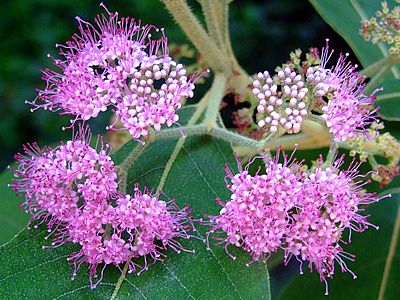Callicarpa nudiflora, popularly known as beautyberry, is a perennial, highly floriferous, and ornamental shrub or small tree, originating from China. This species is part of the Lamiaceae family, which also includes other well-known plants like lavender and mint.
The etymology of the name Callicarpa, which names the genus to which Callicarpa nudiflora belongs, has its roots in the Greek language and is a fusion of two words: “kallos“, meaning “beauty”, and “karpos“, which translates to “fruit”. This name reflects the most distinctive and admired characteristic of the plants in this genus: their beautiful fruits. The specific epithet “nudiflora” is derived from the Latin “nudus“, meaning “naked”, and “flora“, referring to the exposed or bare flowers.
The beautyberry features open, branched foliage, with long tomentose branches when young, lenticellate punctuations, and a brownish trunk with slight scaling. Its leaves are simple, oval-elliptical to lanceolate in shape, with the abaxial (lower) side gray-brown, tomentose, and the adaxial (upper) side dark green and glabrous, with well-marked veins. The leaves of the beautyberry have an interesting characteristic: they emit a mild aroma when crushed, typical of many plants in the Lamiaceae family.
It blooms from mid-summer to mid-fall, displaying dense, tomentose inflorescences laden with numerous small lilac flowers. The flowers, although small, are quite attractive to bees and other pollinators. The fruits appear in the fall and winter and are globular, light pink in color, with small greenish seeds. These fruits are highly ornamental and provide a significant aesthetic appeal to the plant, especially in the fall and winter, when they stand out in the landscape.
Moreover, they are an important food source for various bird species, contributing to local biodiversity. Flocks of different bird species, such as thrushes, tanagers, finches, kiskadees, flycatchers, woodpeckers, doves, and euphonias, among others, appear to feast on the small fruits of the beautyberry.
In landscaping, Callicarpa nudiflora is generally used as an informal shrub, taking advantage of the ornamental beauty of its flowers and persistent fruits. It can form rows and clusters, or be planted individually. With continuous shaping pruning, removing the lower branches, it becomes a graceful small tree, adorning walkways, pavements, squares, and the central beds of avenues. This plant is widely used in sensory gardens due to its tactile and olfactory characteristics. By attracting and feeding birds and pollinating insects, it is recommended for compositions aimed at preserving wildlife and forming bee pastures. It flowers and fruits at an early age.
The beautyberry should be cultivated in full sun or partial shade, in fertile, well-drained soils, enriched with organic matter, and watered regularly in the first year of establishment. It prefers mild climates, adapting better to subtropical to temperate regions. It withstands frosts, as long as they are not too intense. It propagates by seeds, which take about one to three months to germinate.
For a large fruit production, the beautyberry requires cross-pollination, so it is interesting to have more than one plant with a different genotype in the same location. It can also be propagated by semi-hardwood or young hardwood cuttings (from the last growing season), a common multiplication technique for many shrub and tree species.


